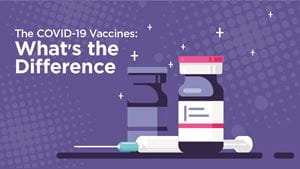
As the new COVID-19 vaccines become available, people who choose to be vaccinated will receive one of the FDA-approved vaccines to help protect them from getting the virus that causes COVID-19. The Pfizer/BioNTech and Moderna vaccines are the two currently available vaccines and both have shown strong efficacy rates above 94% when two doses are taken. While the vaccines are similar in the protection they offer, they differ in other areas.
Here’s a comparison of the Pfizer/BioNTech and Moderna vaccines, with insight from Rochester Regional Health Infectious Disease experts Drs. Maryrose Laguio-Vila and Nadia Kousar.
Both the Pfizer/BioNTech and Moderna COVID-19 vaccines use “messenger RNA” technology (mRNA). mRNA works by using a small amount of protein found on the surface of the virus to spark an immune response in your body. As a result, your body develops antibodies to help fend off any future attacks from the virus. Both the protein and the mRNA are eliminated, while the antibodies stick around to provide you with protection.
mRNA vaccines are different from other conventional vaccines and do not include a live COVID-19 virus in the injection. mRNA provides your body with instructions, like a blueprint, on how to build immunity, instead of using a small sample of the virus to teach your body how to build an immunity. This process contributes to the high efficacy and safety of the Pfizer/BioNTech and Moderna COVID-19 vaccines.
Both COVID-19 vaccines performed exceptionally well in clinical trials.
The Pfizer/BioNTech vaccine was 95% effective against COVID-19 after two doses in trials of more than 40,000 participants.
The Moderna vaccine was 94% effective against COVID-19 after two doses in trials of more than 30,000 participants.
Both vaccines require two doses given a few weeks apart for maximum protection against COVID-19. The Pfizer/BioNTech doses are given 21 days apart and the Moderna doses are given 28 days apart.
“The reason for two doses instead of one is to give you the most protection possible. The first dose primes your body to the foreign substance, and the second dose gives you an extra boost of immunity,” said Dr. Maryrose Laguio-Vila, Infectious Disease expert at Rochester Regional Health.
Both vaccines contain common ingredients found in other effective and safe vaccines.
“The mRNA in each vaccine does most of the heavy lifting, the lipids help deliver the mRNA to your body, and the other ingredients help with pH maintenance and keeps the vaccines stable,” explained Dr. Nadia Kousar, Medical Director of Infectious Disease for the Eastern Region of Rochester Regional Health.
While some mild-to-moderate side effects such as fever, fatigue, headache, and arm soreness have been reported with both vaccines, experts say the vaccines are safe to take.
“Mild side effects are expected after most vaccinations,” said Dr. Nadia Kousar, “Side effects are normal and a sign that the body is building immunity. The commonly reported side effects of this vaccine may affect your ability to do daily activities, but they should go away in a few days.”
Side effects that have been reported with both COVID-19 vaccines include: